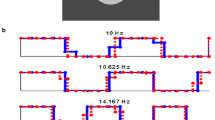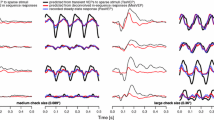Summary
A number of experiments are described in which the visual apparatus of a subject was stimulated by means of periodical rectangular electrical stimuli with variable frequency n, duration t and intensity i. During these experiments (except in those experiments which were performed in complete darkness) the whole visual field was adapted to a brightness corresponding with an illumination of 9,5 lux on perfect white.
The threshold values of i.t.n were determined as a function of n, t and of the state of adaptation.
The following results were obtained:
With small values of t (0.0035 – 0.014 sec.) i as a function of n is constant at low values of n (200–600/min), passes through a minimum at n = 1200 and increases asymptotically at higher values of n. This result is completely in accordance with the results of F. Schwarz (1947) who experimented with alternating (sinusoid) currents. It is shown that the behaviour of the i-n curve can be explained by assuming that the stimulated mechanism shows the phenomenon of “summation of propagated disturbances”. The maximum of “supranormal excitability” is reached 0.05 sec. after stimulation.
i as a function of t shows a minimum at t = 0.05 at low values of n.
It appears that the optimum interval between short stimuli and the optimal duration of long stimuli amounts to the same value (t = 0.05 sec.).
i.t as a function of t behaves according to the well known physiological “laws” of excitation.
With small values of t (t = 0.035) the threshold value of i is independent of the state of adaptation at all values of n. This result is not in agreement with the results of a great number of other investigators, who state that the electrical threshold increases during dark adaptation. At higher values of t the dark measurements become very unreliable. There is perhaps a slight influence of adaptation on the threshold values under these conditions, but the measurements are too unreliable to arrive at a definite conclusion. The large effect of adaptation found by F. Schwarz (1947) for alternating currents cannot be reproduced in our experiments with rectangular stimuli. The theoretical interpretation of such an influence meets with great difficulties.
Résumé
Description d'une série d'expériences dans lesquelles l'organe visuel est excité par des courants électriques appliqués périodiquement sous une forme rectangulaire. Les variables étaient la fréquence (n), la durée de l'excitation (t) et l'ntensité (i). La rétine a toujours été adaptée à un éclairage homogène de 9,5 lux, excepté lorsque l'expérience s'est faite dans l'obscurité complète.
Les seuil de i, t et n ont été détermines par l'apparition de la sensation de flicker, en faisant varier n, t et l'état d'adaption. Une des courbes ainsi établies confirme les résultats obtenus avec des courants alternatifs. De plus, il peut être conclu d'une autre courbe qu'il existe une sensibilité maximale pour les excitations de courte durée, lorsque l'intervalle est de 0.05 sec., et pour les excitations de plus longue durée, lorsque celles-ci sont maintenues 0.05 sec. Ces observations sont interprêtées comme des phénomènes de sommation.
Enfin, il peut être démontré que l'état d'adaptation n'exerce aucune influence sur l'excitabilité électrique, lorsque t est petit (t = 0.035). Lorsque t augmente, l'adaptation à l'obscurité semble avoir une influence défavorable sur l'excitabilité, mais les résultats sont inconstants et il est impossible d'arriver à des conclusions définitives.
Similar content being viewed by others
References
ACHELIS, J. D. & MERKULOW, J. (1929) Die elektrische Erregbarkeit des menschlichen Auges während der Dunkeladaptation. Z. Sinnesphysiol. 60, 95–725.
ADRIAN, E. D. & LUCAS, K. (1912) On the summation of propagated disturbances in nerve and muscle. J. Physiol. 44, 68–124.
BOUMAN, H. D. (1935) Experiments on the electrical excitability of the eye. Arch. néerl. Physiol. 20, 430–445.
— (1940) Electrical excitability of the eye. Ophthalmologica 99, 394–401.
BRUCKNER, A. & KIRSCH, R. (1913) Über den Einfluss des Adaptations-zustandes auf die Empfindlichkeit des Auges für galvanische Reizung. Z. Sinnesphysiol. 47, 46–78.
FISCHER, F. P. & vom HOFE, K. (1932) Über die elektrische Erregbarkeit des menschlichen Auges während der Helladaptation. Arch. Atigenheilk. 105, 443–452.
LASAREFF, P. (1927) Sur la variation périodique de la sensibilité de l'oeil pour les excitations électriques. J. Psychol. Neurol. (Leipz.) 35, 174.
LOHMANN, H. (1940) Über die Sichtbarkeitsgrenze und die optische Unterscheidbarkeit sinusförmiger Wechselströme. Z. Sinnesphysiol. 69, 27–40.
MOTAKAWA, K., IWANA, K. & ENDO, T. (1948) Über den Einfluss unterschwelliger elektrischer Reizung des Auges auf die Lichtempfindlichkeit der Netzhaut. Tohoku J. exp. Med. 49, 331–338.
SCHWARZ, F. (1938) Über die Wirkung von Wechselstrom auf das Sehorgan. Z. Sinnesphysiol. 67, 227–244.
— (1940 a) Über die Reizung des Sehorgans durch niederfrequente elektrische Schwingungen. Z. Sinnesphysiol. 68, 92–118.
— (1940 b) Quantitative Untersuchungen über die optische Wirkung sinusförmiger Wechselströme. Z. Sinnesphysiol. 69, 1–16.
— (1941) Über die Reizung des Sehorgans durch doppelphasige und gleich gerichtete elektrische Schwingungen. Z. Sinnesphysiol. 69, 158–172.
— (1947) Über die elektrische Reizbarkeit des Auges bei Hell- und Dunkel-adaptation. Pflüg. Arch. ges. Physiol. 249, 67–87.
VERRIJP, C. D. (l925 a) L'excitabilité électrique de l'oeil humain. C. R. Soc. Biol. 92, 742–745.
— (1925 b) L'influence de l'adaptation à l'obscurité sur l'excitabilité électrique de l'oeil humain. C. R. Soc. Biol. 93, 55–58.
Author information
Authors and Affiliations
Additional information
We dedicate the present paper to the memory of our great friend F. P. Fischer. We will never forget all he has done for us.
Physical Institute and Ophthalmological Clinic of the University.
Rights and permissions
About this article
Cite this article
Bouman, M.A., ten Doesschate, J. & v. d. Velden, H.A. Electrical stimulation of the human eye by means of periodical rectangular stimuli. Doc Ophthalmol 5, 151–168 (1951). https://doi.org/10.1007/BF00143659
Published:
Issue Date:
DOI: https://doi.org/10.1007/BF00143659




